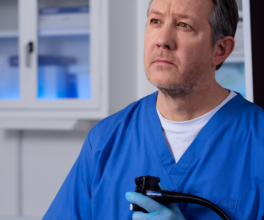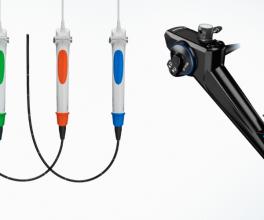
Highlights: Case Study Article, Video a Window into Next-generation Duodenoscope
Adoption of new technology, such as Olympus’ TJF-Q190V duodenoscope, for ERCP procedures does not present a substantial learning curve to Muhammad K. Hasan, MD, FACG, medical director for the Center for Interventional Endoscopy at AdventHealth in Orlando, FL. He used the scope, designed with a disposable distal endcap and features intended to improve visualization, during two clinical cases described in “Drivers Ed: Behind the Wheel of a Next-generation Duodenoscope” (“Article”) (see instructions for downloading this free article at the end of this post).
Unique anatomy, improved view
Dr. Hasan is compared to a driving instructor in the paper, as he carefully and meticulously navigates patient anatomy in the first case: an 85-year-old woman with bile duct stones. The case is of interest for two reasons. First, it highlights the unique anatomy of each patient that GI physicians encounter. “Every papilla behaves differently,” Dr. Hasan remarks during the procedure. “Every papilla has a different shape.”

Muhammad K. Hasan, MD, FACG
The second aspect of interest is how navigating complex anatomy works with the features intended to improve visibility. The TJF-Q190V provides a 15-degree backward “extra” view, compared to the TJF-Q180V.
Dr. Hasan walks viewers through a sphincterotomy in this case, using the Olympus CleverCut3V™ Sphincterotome. The bile duct stone removal demonstrates how balloon dilation “can be tricky,” as he puts it, and he also explains his rationale for his balloon size choice.
Cannulation struggles, stent deployment
In the second case, the patient has a diagnosis of pancreatic adenocarcinoma. According to Dr. Hasan, this is another case in which the TJF-Q190V is beneficial. The square image “gives me a better-quality image, a superior image as compared to the [TJF-Q180V] scope,” he said.
Dr. Hasan says he often performs a sphincterotomy before deploying metal stents out of “concern for a blocked pancreatic orifice.” Hasan chose to use the Olympus HANAROSTENT™ Biliary metal stent featuring a hook-and-cross wire pattern, designed so that “if you compress the center [of the stent] it will not elongate.” After a successful deployment, he adds, “It just spreads like a flower at both ends.”
Get the full story by downloading
and watch the case study video by clicking on the link at the bottom of the paper.
Olympus Corporation of the Americas and its parents, subsidiaries, affiliates, directors, officers, employees, agents, and representatives (collectively “Olympus”) do not represent to or warrant the accuracy, reliability or applicability of the Article.
Muhammad K. Hasan, MD, FACG, the authoring physician of the presentation described in this article, is a paid consultant to Olympus.
For detailed operating instructions on all devices mentioned in this paper, please be sure to follow the device Instruction Manual that was included with the device when purchased.
Improper use of scope may result in patient injury, bleeding, and/or perforation. For full risk information register for www.olympusconnect.com
Olympus is a registered trademark of Olympus Corporation, Olympus America Inc., and/or their affiliates. I Medical devices listed may not be available for sale in all countries.





